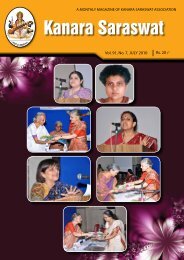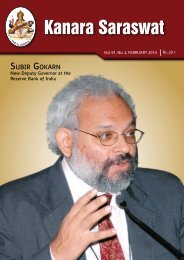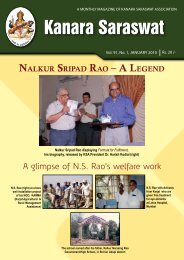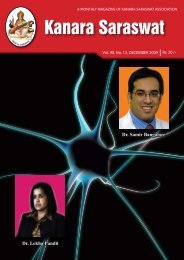Create successful ePaper yourself
Turn your PDF publications into a flip-book with our unique Google optimized e-Paper software.
Types <strong>of</strong> Domestic Violence<br />
Physical, Mental, Psychological and Social<br />
A few illustrations<br />
Beating, rape, insults, taunts, threats, preventing<br />
woman’s access to public and social services such as<br />
health, banks, post <strong>of</strong>fi ce, T.V., radio, written media<br />
and throwing her out <strong>of</strong> the matrimonial home.<br />
Most common causes <strong>of</strong> Domestic Violence in<br />
India<br />
(1) Dowry (2) Suspicion (3) Infertility<br />
(4) Failure to produce a son (5) Adultery<br />
(6) Substance Abuse<br />
A small Puzzle<br />
A young boy was hospitalized after a road accident.<br />
Doctors decided that he needed on operation. A<br />
surgeon was called for the same. The surgeon saw<br />
the boy and said I cannot operate on this boy as he<br />
is my son. But the surgeon was not the boy’s father.<br />
Then who could it have been?<br />
It is rather diffi cult to realize that it was the boy’s<br />
mother!<br />
This is an illustration <strong>of</strong> our mind set. Our<br />
thoughts and language also need to be changed.<br />
When we invite a couple for a meal etc. the usual<br />
statement made is “Bring your wife also”.<br />
To put it crudely, is the wife a dog or a cat? Instead<br />
we could say, “We invite both <strong>of</strong> you for ”. Having<br />
half baked ideas about women’s emancipation, some<br />
men say “My wife is liberated”. I have given her my<br />
permission to do what she likes. But, one can ask as to<br />
who is he to give her the permission? Is she captive?<br />
Remedial Measures to Empower Women<br />
1) Be vigilant regarding the covert and overt<br />
harassment <strong>of</strong> women.<br />
2) Be sensitive to the 4th degree.<br />
3) Locate the pain - study the situation.<br />
4) Offer suggestions but not advice.<br />
5) Give her (girl/women) the choice to select<br />
solutions to her problems, because in the ultimate<br />
analysis, it is her life.<br />
6) If she opts for a wrong solution do not add insult<br />
to injury by saying “I had told you so”. But <strong>of</strong>fer<br />
empathy. This will give her strength to try other<br />
measures.<br />
7) Appreciate the right steps she takes in empowering<br />
herself.<br />
8) Always assure her <strong>of</strong> your support.<br />
Preventive Measures<br />
Non-formal education - which includes:<br />
Informing her <strong>of</strong> the various services available<br />
and how to access them; e.g. a widow (BPL) in<br />
Maharashtra is entitled to Rs. 5,000/- for her<br />
daughters marriage, provided the latter is at least 18<br />
years old; <strong>of</strong>fering knowledge <strong>of</strong> laws which effect<br />
women and children is most necessary; personal<br />
laws which differ according to the religion; laws <strong>of</strong><br />
adoption; laws <strong>of</strong> inheritance and so on.<br />
Facilitating women’s access to services, e.g. police<br />
stations, post <strong>of</strong>fi ces, schools, banks, primary health<br />
centres (in villages) Municipal or State Government<br />
hospitals in the cities and insurance facilities.<br />
Involve the entire family in the process <strong>of</strong><br />
empowerment <strong>of</strong> the women concerned. At times,<br />
it is necessary to involve the community, such as the<br />
slum community and the housing society. (Example<br />
<strong>of</strong> the woman from AP residing in Worli slums. A<br />
woman from AP ran away from her home due to the<br />
harassment not by her husband but by her in-laws.<br />
She came with her 1-1/2 year old son to stay with her<br />
brother and his family who accepted her gladly. But<br />
after a while the AP group in that slum criticised her<br />
brother for keeping a married woman at house. On<br />
my second visit, I explained to the woman the plight<br />
<strong>of</strong> Sita in Ramayan and how she kept her self respect.<br />
She was convinced. Later a meeting with the AP<br />
group in the slum was conducted. The woman stayed<br />
with her brother until her husband came to take her<br />
back with an assurance that they will stay separately.)<br />
Empower women to be self-confi dent and assertive<br />
but not aggressive unless she has no other choice, e.g.<br />
threat to her life.<br />
Impress upon women that there is strength in<br />
unity. Therefore, they can come together and fi ght<br />
KANARA SARASWAT Vol. 91, No.8, <strong>August</strong> <strong>2010</strong> 19
















